Comparison of Projections of Precipitation over Yangtze River Basin of China by Different Climate Models
Abstract
:1. Introduction
2. Materials and Methods
2.1. Study Area
2.2. Data Source
2.3. Data Analysis Methods
3. Results
3.1. Comparison between CIMP5-MME and CMIP6-MME Project Precipitation
3.2. Comparison between CIMP5 and CMIP6 GCMs and Homologous GCMs
4. Discussion
5. Conclusions
Author Contributions
Funding
Institutional Review Board Statement
Informed Consent Statement
Data Availability Statement
Conflicts of Interest
References
- IPCC. Summary for Policymakers. In Climate Change 2021: The Physical Science Basis. Contribution of Working Group I to the Sixth Assessment Report of the Intergovernmental Panel on Climate Change; Masson-Delmotte, V., Zhai, P., Pirani, A., Connors, S.L., Péan, C., Berger, S., Caud, N., Chen, Y., Goldfarb, L., Gomis, M.I., et al., Eds.; Cambridge University Press: Cambridge, UK, 2021. [Google Scholar]
- Nashwan, M.S.; Shahid, S. A novel framework for selecting general circulation models based on the spatial patterns of climate. Int. J. Climatol. 2020, 40, 4422–4443. [Google Scholar] [CrossRef]
- O’Neill, B.C.; Tebaldi, C.; Van Vuuren, D.P.; Eyring, V.; Friedlingstein, P.; Hurtt, G.; Knutti, R.; Kriegler, E.; Lamarque, J.F.; Lowe, J.; et al. The scenario model intercomparison project (Scenario MIP) for CMIP6. Geosci. Model Dev. 2016, 9, 3461–3482. [Google Scholar] [CrossRef] [Green Version]
- Zhang, L.X.; Chen, X.L.; Xin, X.G. Short commentary on CMIP6 Scenario Model Intercomparison Project (ScenarioMIP). Clim. Change Res. 2019, 15, 519–525. [Google Scholar] [CrossRef]
- Chen, X.C.; Xu, Y.; Xu, C.H.; Yao, Y. Assessment of precipitation simulations in China by CMIP5 multi-models. Clim. Change Res. 2014, 10, 217–225. [Google Scholar] [CrossRef]
- Ta, Z.; Yu, Y.; Sun, L.; Chen, X.; Mu, G.; Yu, R. Assessment of Precipitation Simulations in Central Asia by CMIP5 Climate Models. Water 2018, 10, 1516. [Google Scholar] [CrossRef] [Green Version]
- Huang, X.H.; Yue, Q.; Zhang, M. Future precipitation change in the Belt and Road Region under Representative Concentration Pathway Scenarios. J. Yangtze River Sci. Res. Inst. 2020, 37, 53–60. [Google Scholar] [CrossRef]
- Salman, S.A.; Nashwan, M.S.; Ismail, T.; Shahid, S. Selection of CMIP5 general circulation model outputs of precipitation for peninsular Malaysia. Hydrol. Res. 2020, 51, 781–798. [Google Scholar] [CrossRef]
- Zhang, Q.M.; Wang, R.; Jiang, T.; Chen, S.S. Projection of extreme precipitation in the Hanjiang River basin under different RCP scenarios. Clim. Change Res. 2020, 16, 276–286. [Google Scholar] [CrossRef]
- Huang, J.L.; Wang, Y.J.; Su, B.D.; Zhai, J.Q. Future climate change and its impact on runoff in the upper reaches of the Yangtze River under RCP4.5 scenario. Meteor Mon. 2016, 42, 614–620. [Google Scholar] [CrossRef]
- Montroull, N.B.; Saurral, R.I.; Camilloni, I.A. Hydrological impacts in La Plata basin under 1.5, 2 and 3 °C global warming above the pre-industrial level. Int. J. Climatol. 2018, 38, 3355–3368. [Google Scholar] [CrossRef]
- Kim, Y.H.; Min, S.K.; Zhang, X.; Sillmann, J.; Sandstad, M. Evaluation of the CMIP6 MME for climate extreme indices. Weather. Clim. Extrem. 2020, 29, 100269. [Google Scholar] [CrossRef]
- Chen, H.P.; Sun, J.Q.; Lin, W.Q.; Xu, H. Comparison of CMIP6 and CMIP5 models in simulating climate extremes. Sci. Bull. 2020, 65, 1415–1418. [Google Scholar] [CrossRef]
- Zamani, Y.; Monfared, S.A.H.; Moghaddam, M.A.; Hamidianpour, M. A comparison of CMIP6 and CMIP5 projections for precipitation to observational data: The case of Northeastern Iran. Theor. Appl. Climatol. 2020, 142, 1613–1623. [Google Scholar] [CrossRef]
- Bağçaci, S.Ç.; Yucel, I.; Duzenli, E.; Yilmaz, M.T. Intercomparison of the expected change in the temperature and the precipitationretrieved from CMIP6 and CMIP5 climate projections: A Mediterranean hot spot case, Turkey. Atmos. Res. 2021, 256, 105576. [Google Scholar] [CrossRef]
- Kim, J.; Ivanov, V.Y.; Fatichi, S. Climate change and uncertainty assessment over a hydroclimatic transect of Michigan. Stoch. Environ. Risk Assess. 2016, 30, 923–944. [Google Scholar] [CrossRef]
- Zhang, B.; Dai, X.G. Assessment of the deviation of China precipitation projected by CMIP5 models for 2006–2013. Chin. J. Atmos. Sci. 2016, 40, 981–994. [Google Scholar] [CrossRef]
- Monerie, P.A.; Wainwright, C.M.; Sidibe, M.; Akinsanola, A.A. Model uncertainties in climate change impacts on Sahel precipitation in ensembles of CMIP5 and CMIP6 simulations. Clim. Dyn. 2020, 55, 1385–1401. [Google Scholar] [CrossRef]
- Huang, F.; Gan, M.; Yu, Y.; Ta, Z.J.; Zhang, H.Y.; Pi, Y.Y.; Sun, L.X.; Yu, R.D. Error analysis concerning 2006-2017 Central Asia precipitation estimation based on CMIP5 model. J. Univ. Chin. Acad. Sci. 2021, 38, 333–340. [Google Scholar] [CrossRef]
- Han, L.; Song, K.C.; Zhang, W.J.; Liu, L.; Jiang, H.R. Temporal and Spatial Variations of Hydrological Factors in the Source Area of the Yangtze River and Its Responses to Climate Change. J. Mt. Sci. 2017, 35, 129–141. [Google Scholar] [CrossRef]
- Zeng, X.F.; Chen, H.; Zhang, X.Z. Research on Precipitation change sensitive to climate change over Yangtze River Basin. Sci. Technl. Innov. Herald 2009, 8, 237. [Google Scholar] [CrossRef]
- Chu, Q.; Xu, Z.X.; Liu, W.F.; Liu, L. Assessment on 24 global climate models in the CMIP5 over the Yangtze River. Resour. Environ. Yangtze Basin 2015, 24, 81–89. [Google Scholar] [CrossRef]
- Li, J.R.; Niu, Z.G.; Feng, L.; Feng, L.; Yao, R.; Chen, X.X. Simulation and projection of Extreme Temperature Indices in Yangtze and Yellow River Basins by CMIP5 Models. Earth Sci. 2020, 45, 1887–1904. [Google Scholar] [CrossRef]
- Liu, J.L.; Yuan, Z.; Xu, J.J.; Liu, Y.J.; Chen, W.S.; Tian, C.W.; Miao, H.L. Meteorological Drought Evolution Characteristics and Future Trends in the Yangtze River Basin. J. Yangtze River Sci. Res. Inst. 2020, 37, 28–36. [Google Scholar] [CrossRef]
- Han, L.Q.; Han, Z.; Li, S.L. Projection of heavy rainfall events in the middle and lower reaches of the Yangtze River valley in the 21st century under different representative concentration pathways. Trans. Atmos. Sci. 2014, 37, 529–540. [Google Scholar] [CrossRef]
- Liu, F.X.; Wang, Y.J.; Zhao, J.; Chen, X.; Jiang, T. Variations of the exterme precipitation under the global warming of 1.5℃ and 2.0 °C in the mid-lower reaches of the Yangtze River Basin. Resour. Environ. Yangtze Basin 2017, 26, 778–788. [Google Scholar] [CrossRef]
- Zhou, L.; Lan, M.C.; Cai, R.H.; Wen, P.; Yao, R.; Yang, Y.Y. Projection and uncertainties of extreme precipitation over the Yangtze River valley in the early 21st century. Acta Meteor. Sin. 2018, 76, 47–61. [Google Scholar] [CrossRef]
- Wang, Y.J.; Liu, F.X.; Zhai, J.Q.; Wang, Y.Y.; Jiang, T. Variation characteristics of extreme precipitation in the Yangtze River Basin under the global warming 1.5 °C and 2.0 °C. J. Meteor. Sci. 2019, 39, 540–547. [Google Scholar] [CrossRef]
- Zhan, M.Y.; Wang, G.J.; Lu, J.; Chen, L.Q.; Zhu, C.X.; Jiang, T.; Wang, Y.J. Projected evapotranspiration and the influencing factors in the Yangtze River Basin based on CMIP6 models. Trans. Atmos. Sci. 2020, 43, 1115–1126. [Google Scholar] [CrossRef]
- Zeng, X.F.; Zhai, J.Q.; Jiang, T.; Su, B.D. Spatial characteristics and evolutional trends of annual precipitation in the Yangtze River basin. J. Hohai Univ. 2008, 36, 727–732. [Google Scholar] [CrossRef]
- Stefan, B.; Marco, G.; Jiang, T. Observed and Interpolated Precipitation Trends and Variability in the Yangtze Catchment Area. J. Lake Sci. 2003, 15, 123–130. [Google Scholar] [CrossRef] [Green Version]
- Wu, J.; Gao, X.J. A gridded daily observation dataset over China region and comparison with the other datasets. Chin. J. Geophys. 2013, 56, 1102–1111. [Google Scholar] [CrossRef]
- Xu, Y.; Gao, X.J.; Shen, Y.; Xu, C.H.; Shi, Y.; Giorgi, F. A daily temperature dataset over China and its application in validating a RCM simulation. Adv. Atmos. Sci. 2009, 26, 763–772. [Google Scholar] [CrossRef]
- Wu, J.; Gao, X.J.; Giorgi, F.; Chen, D.L. Changes of effective temperature and cold/hot days in late decades over China based on a high resolution gridded observation dataset. Int. J. Climatol. 2017, 37, 788–800. [Google Scholar] [CrossRef]
- Taylor, K.E. Summarizing multiple aspects of model performance in a single diagram. J. Geophys. Res. 2001, 106, 7183–7192. [Google Scholar] [CrossRef]
- Wang, Y.; Li, H.X.; Wang, H.J.; Sun, B.; Chen, H.P. Evaluation of CMIP6 model simulations of extreme precipitation in China and comparison with CMIP5. Acta Meteor. Sin. 2021, 79, 369–386. [Google Scholar] [CrossRef]
- Jiang, D.B.; Hu, D.; Tian, Z.P.; Lang, X.M. Differences between CMIP6 and CMIP5 Models in Simulating Climate over China and the East Asian Monsoon. Adv. Atmos. Sci. 2020, 37, 1102–1118. [Google Scholar] [CrossRef]
- Mohsenipour, M.; Shahid, S.; Chung, E.S.; Wang, X.J. Changing pattern of droughts during cropping seasons of Bangladesh. Water Resour. Manag. 2018, 32, 1555–1568. [Google Scholar] [CrossRef]
- Attogouinon, A.; Lawin, A.E.; Deliège, J.F. Evaluation of general circulation models over the upper oueme river basin in the republic of Benin. Hydrology 2020, 7, 11. [Google Scholar] [CrossRef] [Green Version]
- Gleckler, P.J.; Taylor, K.E.; Doutriaux, C. Performance metrics for climate models. J. Geophys Res. Atmos. 2008, 113, D06104. [Google Scholar] [CrossRef]
- Gusain, A.; Ghosh, S.; Karmakar, S. Added value of CMIP6 over CMIP5 models in simulating Indian summer monsoon rainfall. Atmos. Res. 2020, 232, 104680. [Google Scholar] [CrossRef]
- Srivastava, A.; Grotjahn, R.; Ullrich, P.A. Evaluation of historical CMIP6 model simulations of extreme precipitation over contiguous US regions. Weather Clim. Extrems 2020, 29, 100268. [Google Scholar] [CrossRef]
- Wang, D.; Liu, J.; Shao, W.; Mei, C.; Su, X.; Wang, H. Comparison of CMIP5 and CMIP6 MME for Precipitation Downscaling Results and Observational Data: The Case of Hanjiang River Basin. Atmosphere 2021, 12, 867. [Google Scholar] [CrossRef]
- Ahmadi, M.; Kashki, A.; Dadashi Roudbari, A. Spatial modeling of seasonal precipitation-elevation in Iran based on aphrodite database. Model. Earth Syst. Environ. 2018, 4, 619–633. [Google Scholar] [CrossRef]
- Zhou, Q.X.; Kang, X.; Jiang, X.W.; Liu, Y. Relationship Between Heavy Rainfall and Altitude in Mountainous Areas of Sichuan Basin. Meteor Mon. 2019, 45, 811–819. [Google Scholar] [CrossRef]
- Wu, D.; Jiang, Z.H.; Ma, T.T. Projection of summer precipitation over the Yangtze-Huaihe River basin using multimodel statistical downscaling based on canonical correlation analysis. J. Meteor. Res. 2017, 30, 867–880. [Google Scholar] [CrossRef]
- Salunke, P.; Jain, S.; Mishra, S.K. Performance of the CMIP5 models in the simulation of the Himalaya-Tibetan Plateau monsoon. Theor. Appl. Climatol. 2019, 137, 909–928. [Google Scholar] [CrossRef]
- Zhang, J.; Shi, P.; Yang, J.; Gong, D.Y. The impact of the urbanization process on rainfall in Beijing: A case study of 7.21 rainstorm. Acta Geogr. Sin. 2020, 75, 113–125. [Google Scholar] [CrossRef]
- Sahoo, S.K.; Himesh, S.; Gouda, K.C. Impact of Urbanization on Heavy Rainfall Events: A Case Study over the Megacity of Bengaluru, India. Pure Appl. Geophys. 2020, 177, 6029–6049. [Google Scholar] [CrossRef]
- Chen, H. Validation of the CMIP5 climate models in simulating decadal variations of summer rainfall in eastern China. Clim. Environ. Res. 2014, 19, 773–786. [Google Scholar] [CrossRef]
- Lin, Z.H.; Yang, X.Y.; Cheng, C.L.; Wang, Y.; Chen, H. Capability assessment of CMIP5 models in reproducing observed climatology and decadal changes in summer rainfall with different intensities over Eastern China. Clim. Environ. Res. 2018, 23, 1–25. [Google Scholar] [CrossRef]
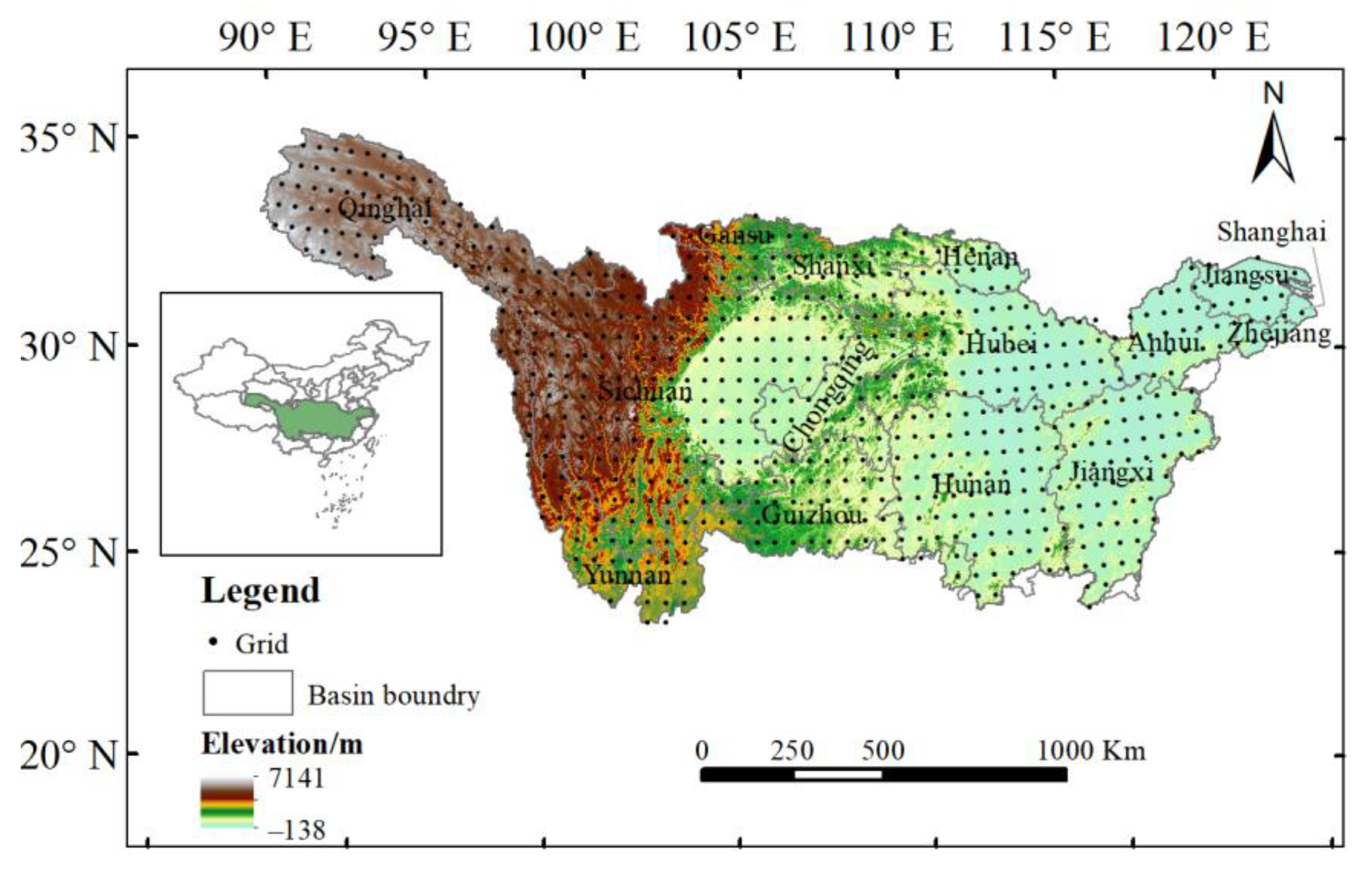
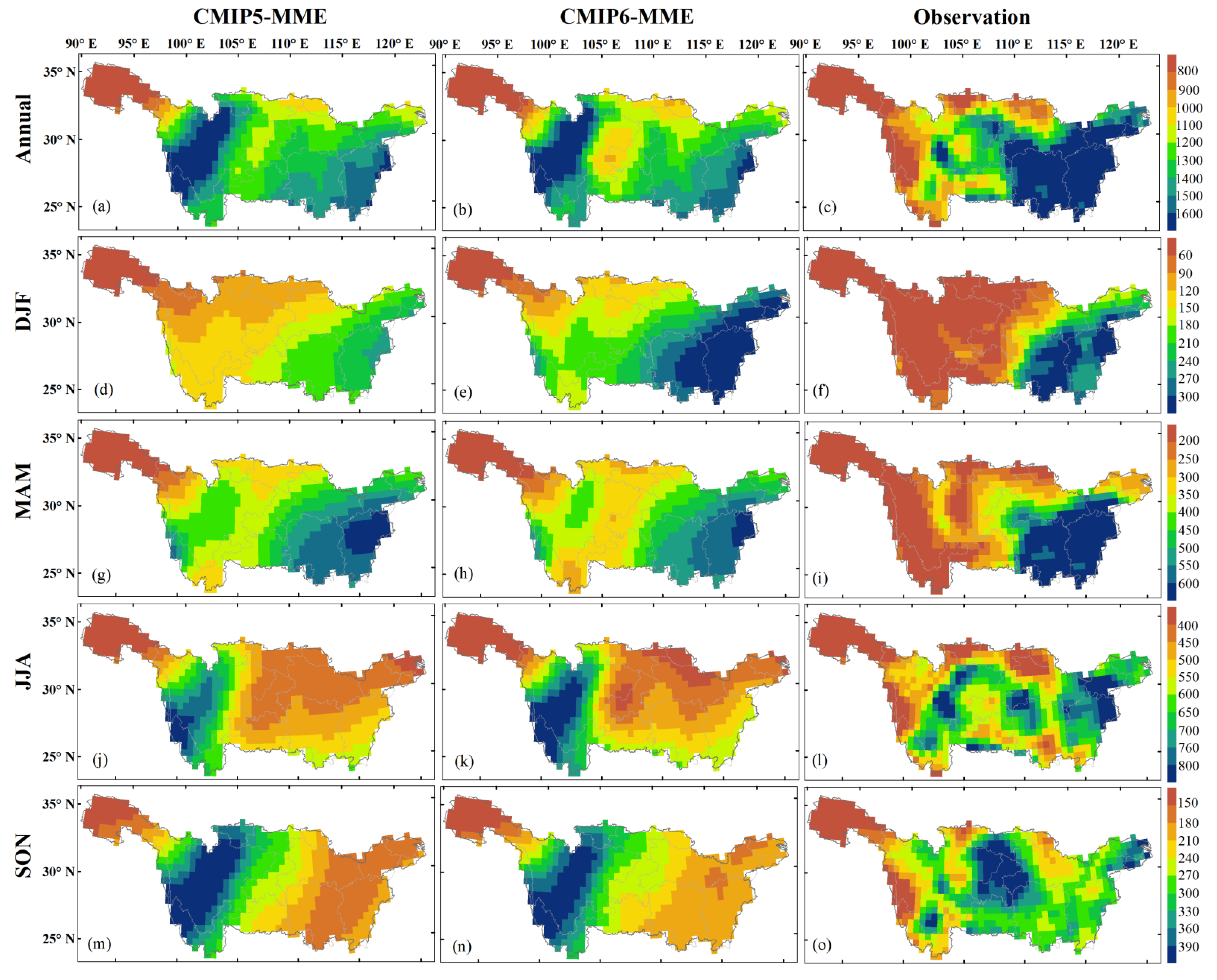


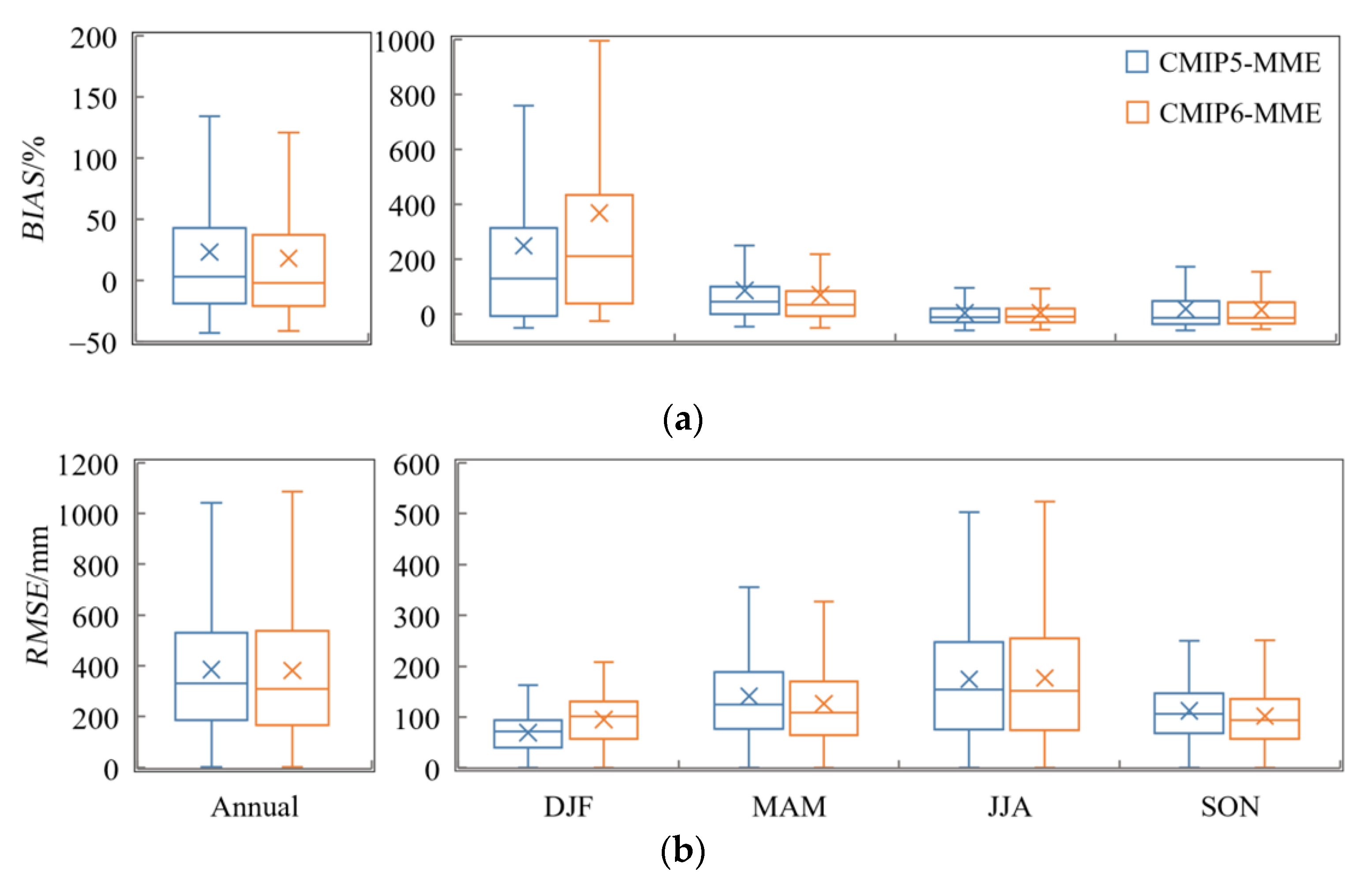
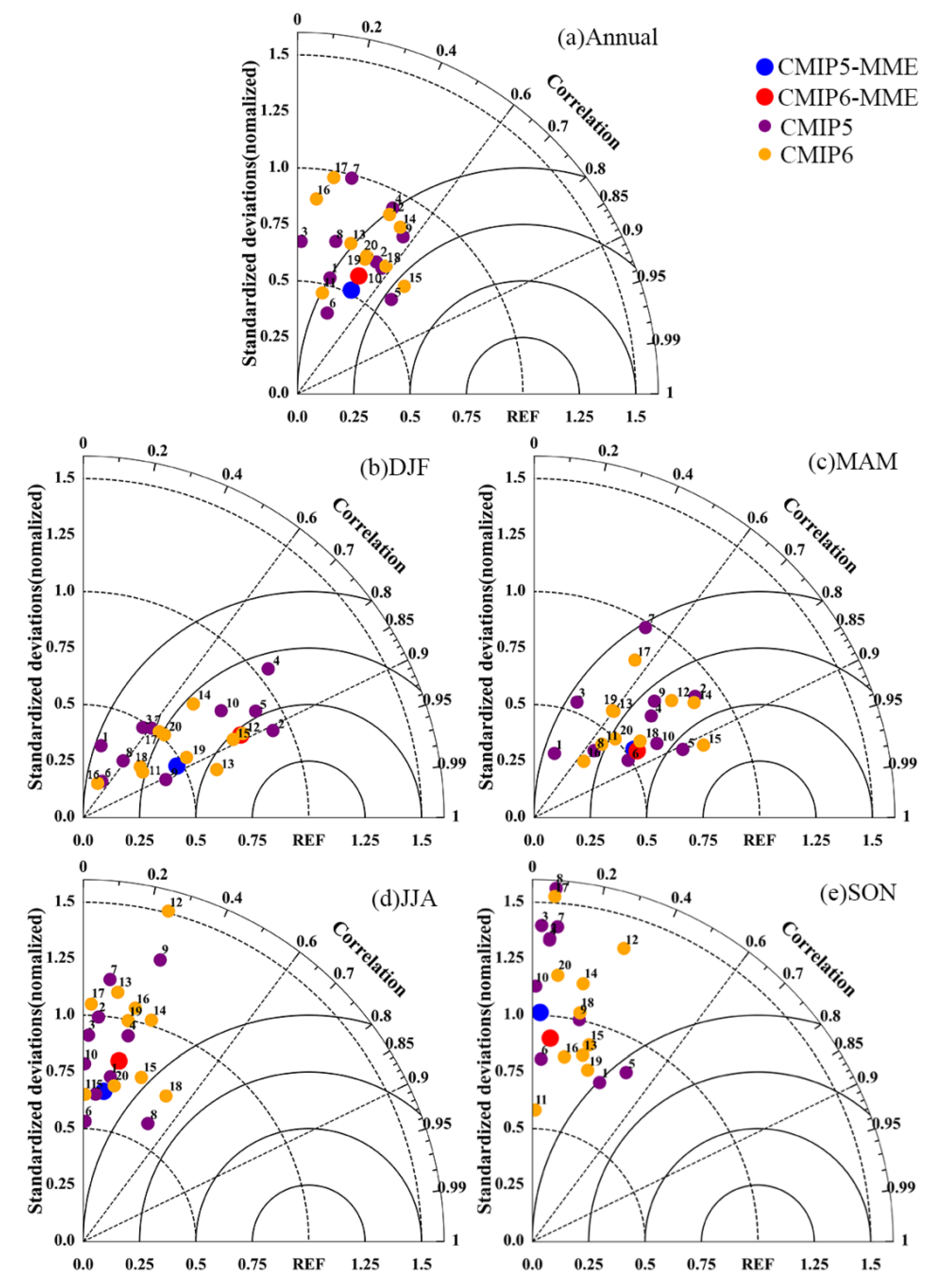
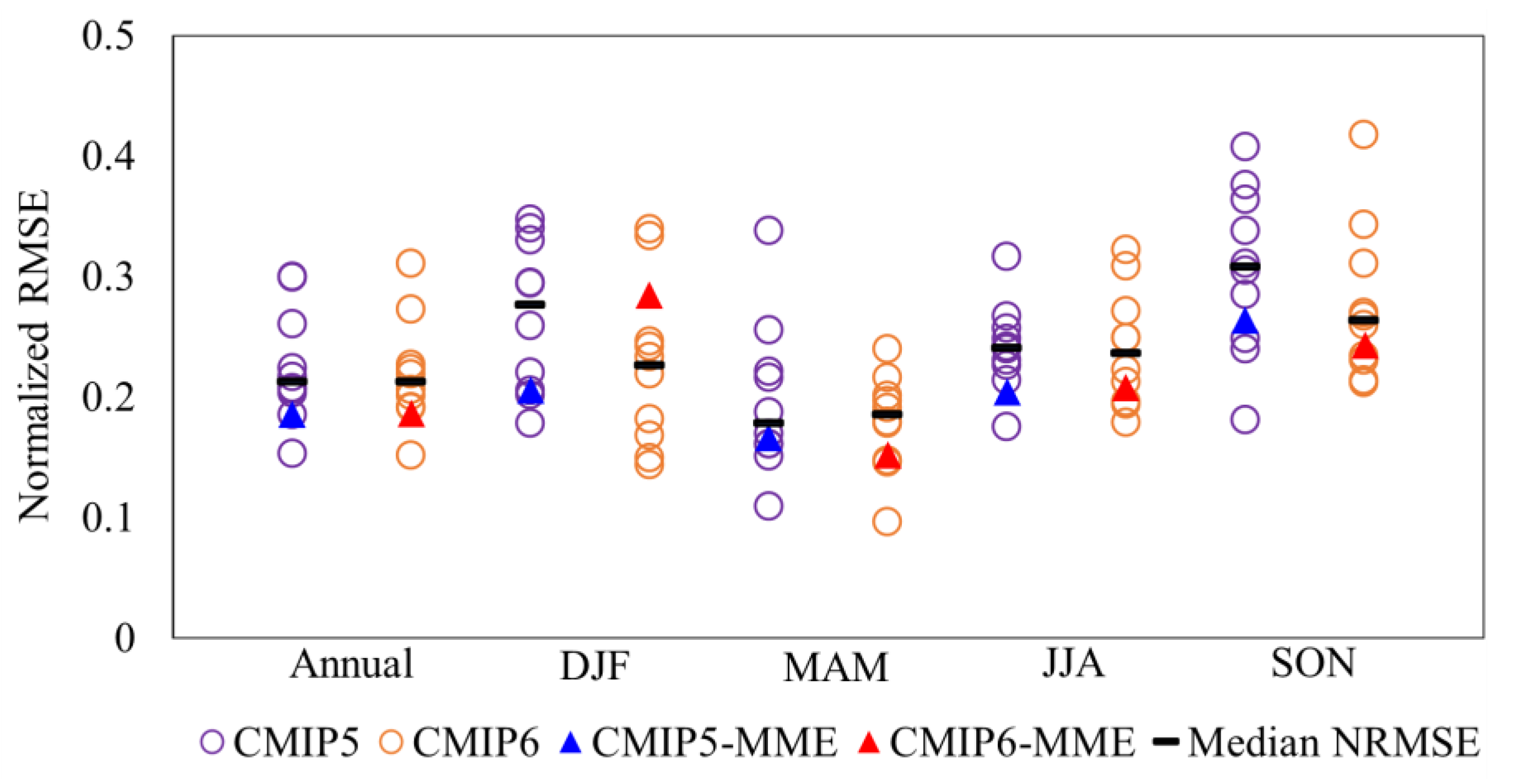
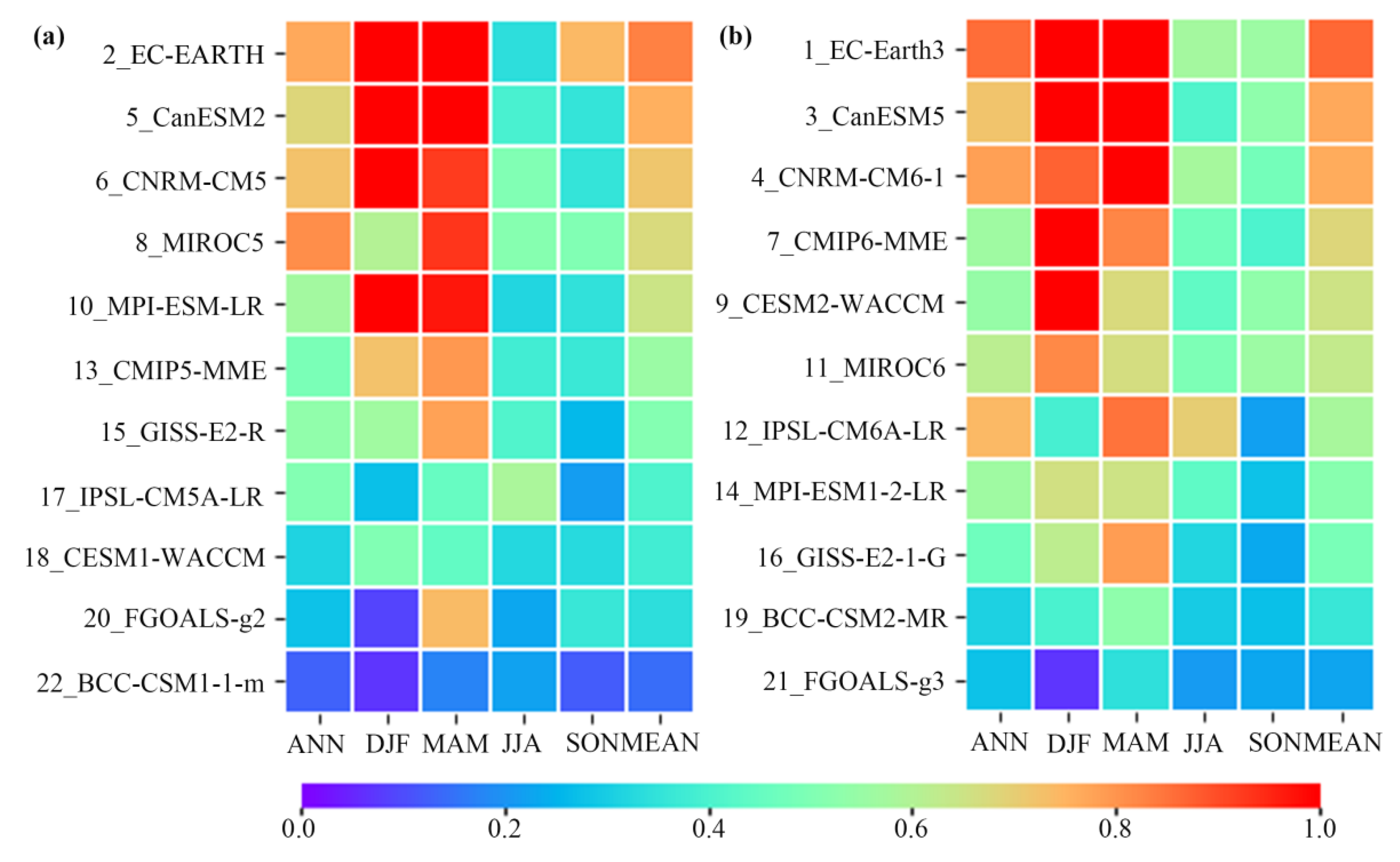
| Model ID | Country or Union | Atmospheric Resolution | |
|---|---|---|---|
| 1 | BCC-CSM1-1-m | China | 1.125° × ~1.1° |
| 2 | CanESM2 | Canada | ~2.8° × 2.8° |
| 3 | CESM1-WACCM | USA | 1.25° × ~0.9° |
| 4 | CNRM-CM5 | France | ~1.4° × 1.4° |
| 5 | EC-EARTH | Europe | 1.125°×~1.1° |
| 6 | FGOALS-g2 | China | ~2.8° × 3–6° |
| 7 | GISS-E2-R | USA | 2.5° × 2° |
| 8 | IPSL-CM5A-LR | France | 3.75° × ~1.9° |
| 9 | MIROC5 | Japan | ~1.4° × 1.4° |
| 10 | MPI-ESM-LR | Germany | 1.875° × ~1.9° |
| 11 | BCC-CSM2-MR | China | 1.125° × ~1.1° |
| 12 | CanESM5 | Canada | 2.8125° × ~2.8° |
| 13 | CESM2-WACCM | USA | 1.25° × ~0.9° |
| 14 | CNRM-CM6-1 | France | ~1.4° × 1.4° |
| 15 | EC-Earth3 | Europe | ~0.7° × 0.7° |
| 16 | FGOALS-g3 | China | 2° × ~2–5° |
| 17 | GISS-E2-1-G | France | 2.5° × 2° |
| 18 | IPSL-CM6A-LR | France | 2.5° × ~1.3° |
| 19 | MIROC6 | Japan | ~1.4° × 1.4° |
| 20 | MPI-ESM1-2-LR | Germany | 1.875° × ~2° |
Publisher’s Note: MDPI stays neutral with regard to jurisdictional claims in published maps and institutional affiliations. |
© 2022 by the authors. Licensee MDPI, Basel, Switzerland. This article is an open access article distributed under the terms and conditions of the Creative Commons Attribution (CC BY) license (https://creativecommons.org/licenses/by/4.0/).
Share and Cite
Pan, H.; Jin, Y.; Zhu, X. Comparison of Projections of Precipitation over Yangtze River Basin of China by Different Climate Models. Water 2022, 14, 1888. https://doi.org/10.3390/w14121888
Pan H, Jin Y, Zhu X. Comparison of Projections of Precipitation over Yangtze River Basin of China by Different Climate Models. Water. 2022; 14(12):1888. https://doi.org/10.3390/w14121888
Chicago/Turabian StylePan, Hong, Youjie Jin, and Xiaochen Zhu. 2022. "Comparison of Projections of Precipitation over Yangtze River Basin of China by Different Climate Models" Water 14, no. 12: 1888. https://doi.org/10.3390/w14121888







